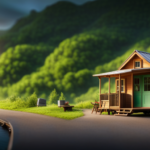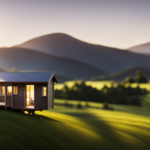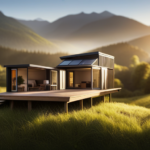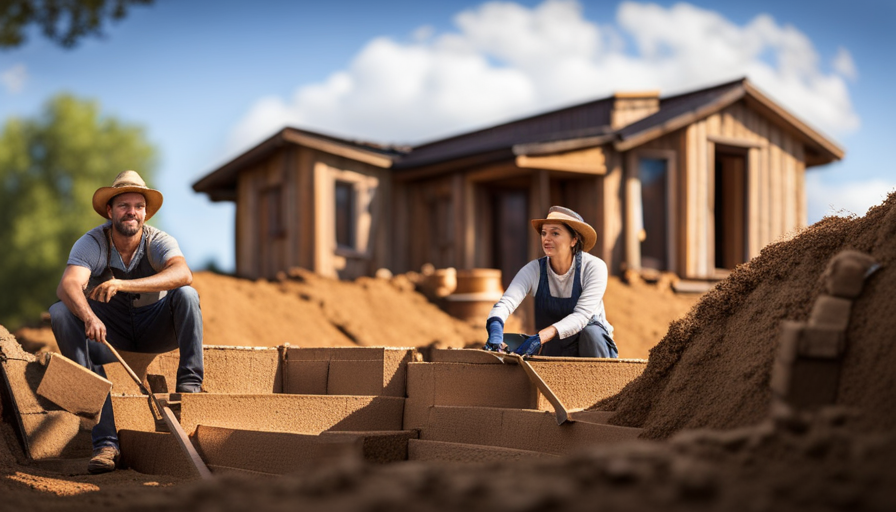What is the cost of a tiny house on wheels?
This burning question has captivated the minds of many aspiring homeowners looking to downsize and embrace a simpler, more sustainable lifestyle. With the growing popularity of tiny houses on wheels, it’s crucial to delve into the nitty-gritty details and crunch the numbers before embarking on this unique housing journey.
In this article, we will explore the financial aspects of owning a tiny house on wheels, considering factors such as budget, size, design, building materials, labor costs, customizations, financing options, and even long-term financial benefits. By analyzing the data and unraveling the intricacies of tiny house costs, we aim to provide you with a comprehensive understanding of the financial commitment required for this alternative housing option.
So, let’s dive into the realm of tiny house economics and discover the true cost of turning a dream into a reality.
Key Takeaways
- Factors to consider when owning a tiny house on wheels include budget, size, design, building materials, labor costs, customizations, financing options, and long-term financial benefits.
- Thoroughly research and budget for all costs including materials, labor, permits, customization, maintenance, insurance, and parking fees.
- Consider size, design, and building materials carefully, as they can significantly impact the overall cost.
- Explore financing options and loans tailored for tiny houses on wheels, and compare lenders and loan programs for favorable terms.
Consider Your Budget and Financial Situation
Are you wondering how much a tiny house on wheels will set you back and if it’s within your budget? Budgeting tips and financial planning are crucial when considering the cost of a tiny house on wheels.
Before diving into the details, take a close look at your financial situation and determine how much you can afford to spend on your tiny house. Consider your income, expenses, and any existing debts or financial obligations. It’s important to be realistic and ensure that you won’t be financially strained by this investment.
Once you have a clear understanding of your budget, you can start exploring the various costs associated with a tiny house on wheels. This includes the cost of materials, labor, permits, and any additional features or customization you desire. Conduct thorough research and gather quotes from builders to get a better idea of the potential expenses.
Remember, budgeting for a tiny house on wheels is not just about the initial cost. You should also factor in ongoing expenses such as maintenance, insurance, and parking fees if you plan to live in a community or on someone else’s property.
By carefully considering your budget and financial situation, you can make an informed decision about whether a tiny house on wheels is feasible for you. Once you have a clear understanding of the financial aspect, you can move on to determining the size and design of your tiny house.
Determine the Size and Design of Your Tiny House
Deciding on the dimensions and style of my compact abode, have you ever envisioned the quaint charm of a cottage nestled on wheels?
When determining the size and design of your tiny house, it’s essential to consider both the cost of materials and size considerations. The cost of materials will vary depending on the size of your tiny house. Generally, the larger the house, the more materials will be required, and thus, the higher the cost. It’s important to carefully plan and budget for the cost of materials, as this can significantly impact your overall budget.
Size considerations are also crucial when designing your tiny house. The size of your tiny house will determine its functionality and livability. You must carefully consider your needs and lifestyle when determining the size of your tiny house. Additionally, local zoning regulations and building codes may have limitations on the maximum size of a tiny house on wheels, so it’s essential to research these requirements before finalizing your design.
As you consider the size and design of your tiny house, it’s crucial to research different building materials and their costs. This will allow you to make informed decisions and ensure that your budget aligns with your vision for your compact abode.
Research Different Building Materials and Their Costs
When researching different building materials for your compact abode, envision the beauty and durability of reclaimed wood and the rustic charm it can bring to your tiny house on wheels. Reclaimed wood is an excellent option for those seeking sustainable and eco-friendly materials. It not only adds character to your tiny home but also helps reduce the carbon footprint.
Other building material options include steel and concrete, which offer strength and durability. However, these materials may be more expensive compared to reclaimed wood.
When considering the cost of different building materials, it’s important to compare their prices. Reclaimed wood can vary in cost depending on factors such as the type of wood, its condition, and the supplier. Steel, on the other hand, is generally more expensive due to its structural properties. Concrete can also be costly, especially if you opt for high-quality mixes or decorative finishes.
To make an informed decision about the building materials for your tiny house on wheels, consider your budget and priorities. Reclaimed wood may be a more affordable and environmentally friendly option, while steel and concrete offer durability and strength. Factor in labor and construction costs to determine the overall expenses for your project.
Next, we’ll explore how these costs can impact your budget.
Factor in Labor and Construction Costs
Considering labor and construction costs is crucial to ensuring the financial feasibility of your compact abode project and avoiding any unexpected expenses. Labor and construction costs can significantly impact the overall price of a tiny house on wheels. To accurately estimate these costs, a cost breakdown analysis is necessary.
Labor costs encompass the wages of the builders and contractors involved in the construction process. The complexity of the design and the level of customization required can influence these costs. Additionally, the location of the build and the availability of skilled labor may also affect labor expenses.
Construction costs include the materials needed to build the tiny house on wheels. This encompasses everything from the foundation and framing to the roofing and insulation. The specific materials chosen can greatly impact the overall cost. For example, high-end finishes and eco-friendly materials may be more expensive.
To accurately determine labor and construction costs, it’s essential to obtain detailed quotes from contractors and suppliers. Comparing multiple quotes can help identify the most cost-effective options while still maintaining quality.
By thoroughly considering labor and construction costs, you can ensure that your budget for customizations and additional features aligns with your overall financial plan. This will help you create the perfect tiny house on wheels without breaking the bank.
Budget for Customizations and Additional Features
Plan for your dream features and personal touches, ensuring that your budget allows for the perfect finishing touches that make your compact abode uniquely yours. Customization expenses and additional feature costs should be taken into account when determining the overall cost of your tiny house on wheels. These expenses can vary greatly depending on your preferences and the complexity of the customizations.
To help you understand the potential costs involved, consider the following table:
| Customization/Additional Feature | Average Cost |
|---|---|
| Upgraded kitchen appliances | $2,000 |
| Solar panels | $5,000 |
| Built-in storage solutions | $1,500 |
| High-end bathroom fixtures | $3,000 |
| Outdoor deck or patio | $2,500 |
Keep in mind that these are just average costs and can vary based on factors such as the quality of materials used and the level of customization desired. It’s important to carefully consider which features are essential to your lifestyle and prioritize them within your budget.
As you plan for customizations and additional features, don’t forget about utilities and hookups. These necessary components can add to the overall cost of your tiny house on wheels, so it’s important to factor them in when budgeting.
Don’t Forget About Utilities and Hookups
Make sure you don’t overlook the importance of utilities and hookups, as they can be a significant expense when setting up your compact home on wheels. When considering the cost of a tiny house on wheels, it’s important to factor in the expenses associated with utilities such as electricity, water, and sewage.
Depending on your location and preferences, there are a variety of options to consider. Off-grid alternatives, for example, allow you to live completely self-sufficiently without relying on traditional utilities. These options may include solar panels for electricity, rainwater collection systems for water, and composting toilets for sewage. While these alternatives can be more expensive initially, they offer long-term cost savings and a more sustainable lifestyle.
In addition to off-grid alternatives, there are also sustainable living options that can help reduce utility costs. For example, energy-efficient appliances and insulation can significantly lower your electricity bill. Additionally, using sustainable building materials and designing your tiny house with energy-efficient principles in mind can further reduce your environmental impact and utility expenses.
When researching financing options and loans for your tiny house on wheels, it’s important to consider the cost of utilities and hookups. Understanding the potential expenses associated with utilities will help you determine your budget and ensure you can afford all aspects of your compact home on wheels.
Research Financing Options and Loans
To find the best financing options and loans for your compact home on wheels, you’ll need to research and explore different lenders and programs available to make your dreams of a mobile lifestyle a reality.
Start by considering financing options specifically tailored for tiny houses on wheels. Some lenders offer loans specifically for these types of homes, which can help simplify the borrowing process. Look for loan terms that suit your financial situation and goals. Consider the interest rate, repayment period, and any potential fees associated with the loan.
It’s essential to compare different lenders and loan programs to find the most favorable terms. Look for lenders who have experience with financing tiny houses on wheels and understand the unique considerations associated with them. Additionally, explore government-backed loan programs, such as FHA loans, which can offer more flexible terms and lower down payment requirements.
When researching financing options, be sure to consider your credit score and financial history. Lenders will review these factors when determining your loan eligibility and interest rate. Taking steps to improve your credit score beforehand can help you secure better loan terms.
Once you have a clear understanding of your financing options and have chosen the most suitable loan, you can transition into considering the cost of land or parking for your tiny house.
Consider the Cost of Land or Parking for Your Tiny House
If you’re ready to embark on your mobile lifestyle, finding the perfect piece of land or parking spot for your compact home on wheels will be a serendipitous adventure. However, it’s important to consider the cost of parking and any zoning regulations that may impact your choice.
The cost of parking for a tiny house on wheels can vary greatly depending on the location and amenities available. Some areas may offer dedicated tiny house communities or RV parks that cater specifically to mobile homes, while others may require you to rent or purchase a plot of land. It’s important to research the costs associated with each option and factor them into your overall budget.
Additionally, zoning regulations can also affect where you can park your tiny house. Some areas have specific regulations regarding the size and type of structures that can be parked on private property, while others may restrict parking to designated areas. Understanding these regulations can help you avoid any potential legal issues or fines.
Once you have considered the cost of land or parking for your tiny house, the next step is to calculate maintenance and upkeep costs.
Calculate Maintenance and Upkeep Costs
Once you’ve settled into your dream tiny home, it’s essential to consider the ongoing expenses that come with maintaining and keeping up your cozy living space. While tiny houses on wheels are generally more cost-effective than traditional homes, there are still some maintenance and upkeep costs to take into account.
One of the cost-saving tips for maintaining a tiny house on wheels is to invest in high-quality materials and appliances from the start. This may seem like a larger upfront expense, but it can save you money in the long run by reducing the need for frequent repairs or replacements.
Another potential hidden expense is insurance. While tiny houses on wheels may be less expensive to insure compared to larger homes, it’s still important to factor in this cost. Shop around for the best insurance rates and consider bundling your tiny house insurance with your auto or other policies to save money.
Regular maintenance tasks such as cleaning, painting, and sealing should also be accounted for. These tasks not only keep your tiny house looking its best but also help prevent more costly repairs down the line.
While there are ongoing expenses associated with maintaining a tiny house on wheels, there are also cost-saving tips that can help mitigate these costs. By investing in quality materials, finding affordable insurance, and staying on top of regular maintenance, you can enjoy the benefits of tiny house living without breaking the bank.
Now, let’s explore the long-term financial benefits of living in a tiny house on wheels.
Explore the Long-Term Financial Benefits of Living in a Tiny House on Wheels
Consider the numerous long-term financial advantages that come with residing in a compact dwelling on wheels. When it comes to tiny houses on wheels, the cost savings can be significant.
One of the main benefits is the long-term savings on housing expenses. With a tiny house, you can drastically reduce or even eliminate mortgage payments, property taxes, and utility bills. This can free up a significant portion of your income, giving you more financial freedom and independence.
In addition to housing expenses, maintenance and upkeep costs are also much lower with a tiny house on wheels. Since these homes are smaller and more efficient, they require less maintenance and fewer repairs. This can save you a substantial amount of money in the long run.
Furthermore, the smaller size of a tiny house means you’ll have fewer belongings, which can lead to lower expenses for furniture, appliances, and other household items.
Living in a tiny house on wheels also allows you to save money on transportation. With the ability to move your home wherever you desire, you can avoid the costs of commuting or relocating to a new area. This flexibility can provide you with opportunities for job changes or travel without the burden of high moving costs.
Overall, residing in a tiny house on wheels offers long-term financial benefits such as savings on housing expenses, reduced maintenance costs, and the ability to save money on transportation. These advantages can lead to greater financial independence and a more secure future.
Frequently Asked Questions
What are some common financing options and loans available for building a tiny house on wheels?
There are various financing options and loans available for building a tiny house on wheels. Some common options include personal loans, RV loans, and construction loans specifically designed for tiny house projects.
How much does land or parking typically cost for a tiny house on wheels?
Buying land or finding parking for a tiny house on wheels can be a challenge and costly. Factors such as location, size, and zoning regulations greatly influence the cost. Additionally, insurance costs may vary depending on the area and the coverage needed.
Are there any maintenance and upkeep costs associated with living in a tiny house on wheels?
Living in a tiny house on wheels incurs maintenance costs, which depend on factors like size and materials. However, the energy efficiency of these houses can help reduce long-term maintenance expenses, making them a cost-effective option.
What are some long-term financial benefits of living in a tiny house on wheels?
Long term financial benefits of living in a tiny house on wheels include reduced utility bills, lower maintenance costs, and potential for rental income. Additionally, it promotes environmental sustainability by minimizing energy consumption and reducing carbon footprint.
What are some potential customizations and additional features that can be budgeted for in a tiny house on wheels?
Some potential customizations and additional features for a tiny house on wheels include solar panels, composting toilets, and custom storage solutions. These options can be budgeted for to enhance the functionality and sustainability of the tiny house.
Conclusion
In conclusion, after carefully considering the budget, size, design, building materials, labor, customizations, financing options, land or parking costs, maintenance, and long-term financial benefits, it’s evident that a tiny house on wheels offers a cost-effective alternative to traditional housing.
By embracing the minimalist lifestyle, individuals can achieve financial freedom and a sense of liberation. The allusion to the ‘less is more’ philosophy underscores the value and practicality of tiny house living, making it a compelling choice for those seeking a more sustainable and affordable way of life.
Hi, I’m Emma. I’m the Editor in Chief of Tiny House 43, a blog all about tiny houses. While tree houses are often associated with childhood, they can be the perfect adult retreat. They offer a cozy space to relax and unwind, surrounded by nature. And since they’re typically built on stilts or raised platforms, they offer stunning views that traditional homes simply can’t match. If you’re looking for a unique and romantic getaway, a tree house tiny house might just be the perfect option.
















